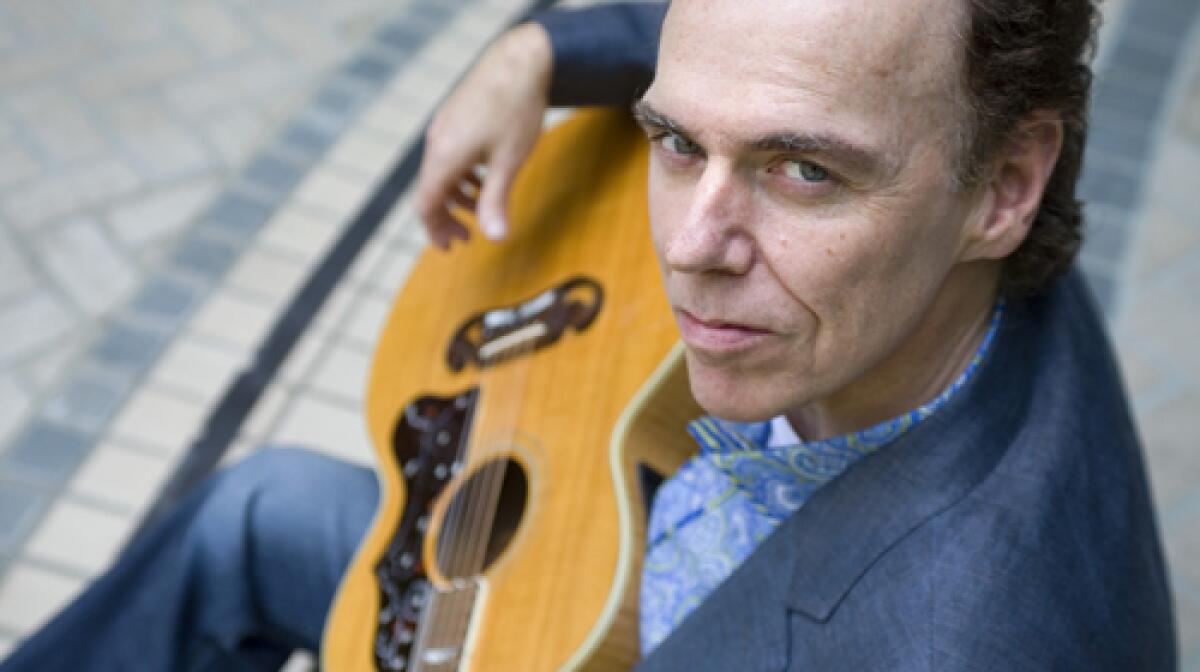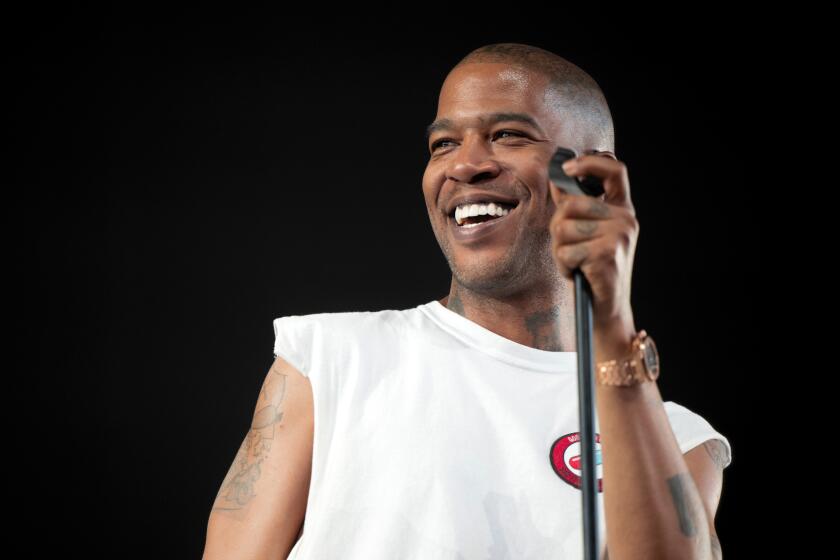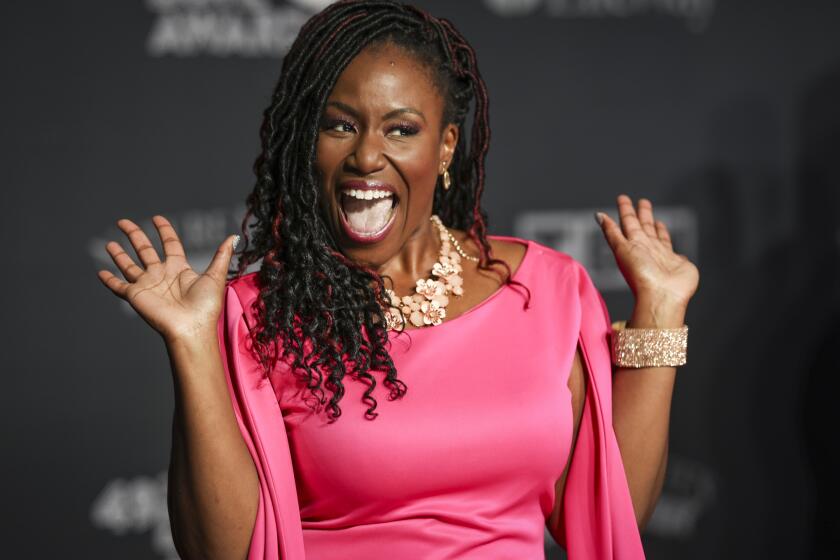For John Hiatt, words follow

JOHN HIATT has recorded a string of critically lauded albums dating to the mid 1970s, but his profile rose markedly in 1987 with “Bring the Family,” an intimate collection of songs exploring relations between friends and lovers, husbands and wives, parents and children. It included “Thing Called Love,” which Bonnie Raitt subsequently popularized when she included it on her multiple Grammy-winning “Nick of Time” album in 1989.
FOR THE RECORD:
John Hiatt: An interview with singer-songwriter John Hiatt in Sunday’s Arts & Music section described him as an Illinois native. Hiatt is from Indiana. —
The Illinois native, who will receive a lifetime achievement award for songwriting this week at the Americana Music Assn. conference in Nashville, recently explained how he wrote that song, probably his best known, and “What Love Can Do” from his latest CD, “Same Old Man.”
“These two were kind of good contrasts because they are both ends of a long relationship that inspired both songs,” Hiatt, 56, said. “One is from the beginning, the other one comes after 22 years of marriage. They had different inspirations, but they’re about the same person and the same relationship.”
Indeed, emotionally rich songs about the upside of relationships have become a hallmark of Hiatt’s body of work, which he discussed over lunch on a return visit to L.A., where he lived and worked in the early 1980s.
“It’s not my long suit -- relationships,” he said. “But the creative tension, I guess, gives me endless amounts of material to work with. It just so happened in my life at one point that I met my wife and we fell in love and we’ve been together for 22 years. That’s informed my writing in a huge way for the last 20 to 22 years.”
“Before that,” he says, “I wrote about relationships that weren’t working so well.”
How does a song typically begin -- with an idea you want to explore, with an evocative catchphrase or with a melody or chord progression?
I almost always start off with the music. . . . I’ll be honest with you, lyrics really come out of necessity: You don’t want to sing something silly. Really it just starts there. For me the lyrics are actually formed by the music . . . that’s why I hate to have the lyrics separated from the song. I’m a little uncomfortable with that, because it’s not really poetry per se. At least my lyrics aren’t. They don’t stand up by themselves. The lyrics are so involved in the chord structure and the melody and the sound of the words. So when I’m writing the melody and the music, nine times out of 10, I start singing nonsense sounds, and out of that comes a lyric direction. . . . Then I don’t know what happens, an emotional thing gets in there. I hook up with some muse or whatever, and a story of some kind, some kind of narrative, starts to emerge. That’s when you kind of feel like you’re getting into the spaceship and taking a little trip somewhere, through a tale that I don’t even know the ending of. That’s exciting.
“Thing Called Love” opens with an instantly recognizable five-note guitar riff. [Watch Hiatt perform the song live here.] Is that the first thing that came to you?
No, it was that rhythm. I had that sort of loopy rhythm that’s in betweeny. I had that rhythm and that weird chord structure: It was down in an F-sharp thing, lifted up to the A, down to the E then back to the F-sharp major, then lifted up into key of D for the chorus. It’s the typical three chords in chorus -- D-G-A-D; kinda like two songs in a way. In the verse, it has almost an ominous feeling, as if you’re going somewhere you’ve never been.
The lyrics came out of the actual sound of the music. Of course, I was falling in love with my wife at the time. I had the fire in my belly, romantically I was just head over heels, but I was scared, which you can hear in the lyrics obviously. I’m hedging my bets at every turn, talking tough: “You ain’t no Queen of Sheba . . . we’re not amoebas,” so don’t try and make me one. Don’t try to make me a dull husband, little Missy! I’m not going there; I’m a rough and tough musician. . . . It has that kind of attitude in the verse. In the chorus, it’s sweetness and light, but I’m still trying to maintain my control over the situation.
And how did the lyric develop?
I think that first verse just kind of popped out.
Don’t have to humble yourself to me
I ain’t your judge or your king
Baby, you know you ain’t no Queen of Sheba
We may not have our own dignity, no
This could be just a prideful thing
Baby, we can choose you know we ain’t no amoebas
Then it was like “This is gonna be fun.” I like the idea of “We’re gonna start on equal terms: You don’t have to humble yourself to me. I’m not a judge, a king -- I’m none of that crap. And you’re not going to pull that [stuff] on me either.” That was what I was trying to tell her: “Let’s get the rules of the game straight right up front.” [He laughs] I was terrified basically, because I was head over heels, out of control. New love’s in deep, there was no way out.
Did the band you recorded it with -- guitarist Ry Cooder, bassist Nick Lowe and drummer Jim Keltner -- help shape the song itself?
I had everything when we went to record it, but Nick Lowe came up with that riff -- ba dir di dir dit -- which is the icing on the cake. As soon as he started playing that on the bass, Ry started playing it on the guitar, and he was laughing, “Oh, that’s great.” And that was pretty much the arrangement.
In the new song “What Love Can Do,” you suggest that you and your partner exchange her tiara and your crown for pauper’s rags. Was that a direct reference back to the Queen of Sheba?
I was musing over how you start out with all these expectations -- of each other, of yourself, of marriage, of every damn thing. I want more and I want it now. Then you realize how little you need and how happy you are with just each other. And that’s the opening line: “We were always happy when we needed the least/Who knew this love would turn into such a feast.” That line popped out as I was strumming those chords. I had that change from C to E minor to F, back to C and then G. I just loved the feel and all of a sudden I just sang that line. It’s that deceptively simple thing that I’m real fond of when you can hit it.
The lyrics just started coming from there. I’d been reading this cool book about St. Francis of Assisi called “God’s Fool.” The author was writing about St. Francis, who was born into a rich family, in Italy, in Assisi. His father was a wealthy cloth merchant. St. Francis grew up, was quite a dandy, and when he hit his teenage years, he was a party boy, everybody’s favorite, a leader of the lost boys, the partyer. Then he turned on all that, realized he didn’t want to live that way and he dressed in pauper’s rags. I was so taken by whatever his conversion was -- he wound up building churches. I was just struck by that, so that’s how those “pauper’s rags and worn-out shoes” got in there.
Can you imagine feeling that much love? If you’re that willing to count on the kindness of strangers. Now that’s love. I can’t go there, but wow-ee.
A song about a healthy relationship isn’t very rock ‘n’ roll. How do you make it interesting?
You reach that point where the depth of love you can get to between two people who wanted to go there . . . you just keep being amazed by it. Who knew indeed, that 22 years later, after the kids have left the house, finally, you would feel more romantic than when you first met? Plus there’s all the love you’ve built up, love and understanding and friendship and all of that. And it all feels new because we’ve never been here before. So you even feel more like a kid. Contrary to what you hear people say about “Oh, they’re an old married couple”; you have this notion -- they’re old, they’re tired, it’s not fun anymore. It’s anything but that. It’s like “Wow, where are we? This is amazing!” It’s unbelievable really. It’s like Jules Verne or something.
More to Read
The biggest entertainment stories
Get our big stories about Hollywood, film, television, music, arts, culture and more right in your inbox as soon as they publish.
You may occasionally receive promotional content from the Los Angeles Times.






